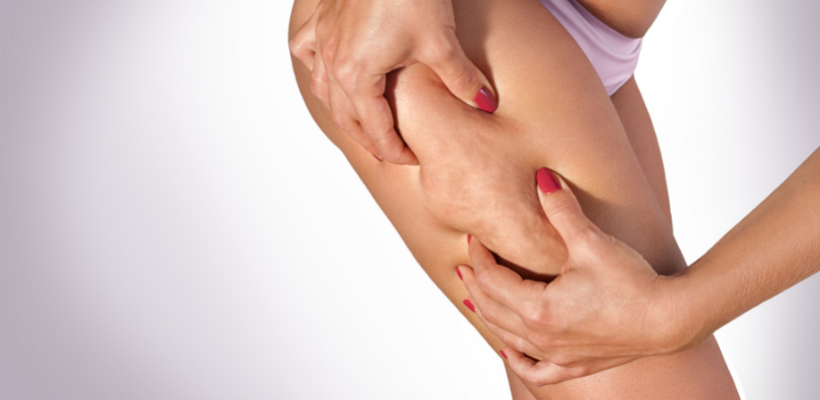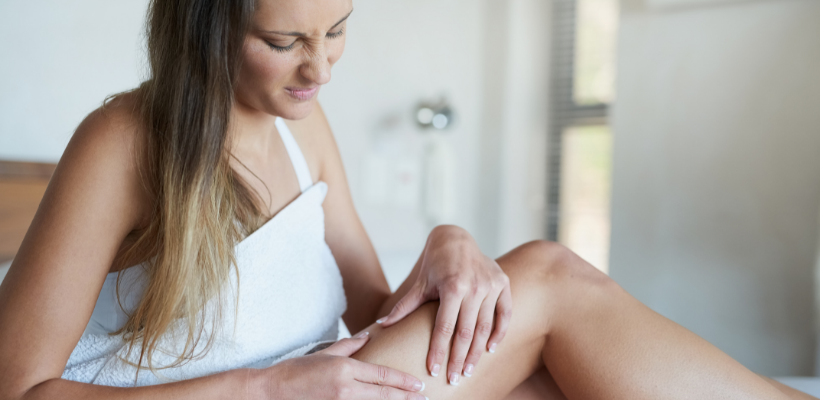
Definition and a (very) brief history
Cellulite is a harmless skin condition in which skin resembles the surface of an orange peel (in texture, not color). Fibrous cords—called septae—connect the skin to the muscle underneath, passing through the fat just under the skin. These tough cords pull down on the skin while the fat pushes up, causing a dimpled appearance. The Mayo Clinic has a good illustration of this. Some mild cellulite is only visible if you squeeze the skin in the area, while more pronounced cellulite is always visible, making skin look permanently dimpled or bumpy.
The word “cellulite” may sound like a simplified phone (cellular + lite) but it actually comes from the French cellule meaning “cell” and ite as in “itis.” If you are curious, Kelsey Miller has written a great overview of the history of the word and its role in French and world beauty standards. The word first appeared in English in Vogue in 1968, and a bit less than ten years later, in 1977, a paper was presented at an international dermatology conference called “So-Called Cellulite: An Invented Disease,” given the fact that it is, essentially, a harmless and normal condition which affects somewhere between 80 and 98% of women.
What causes cellulite?
Even though most women have some amount of cellulite on their bodies, scientists are still puzzled about its cause. Their current best guess is that it does not seem to be due to the fat cells specifically, or to any particular characteristics of the skin, but instead to the fibrous cords—the septae—and their interplay with skin. The risk of developing cellulite is increased with weight gain or pregnancy, but lean, fit people can have cellulite as well. There may be genetic factors as underlying causes as well, such as those determining skin and body type, as well as hormones.
Treatments for cellulite that target the fat (such as liposuction) do not work, or they do not work as well as treatments that target the septae (fibrous cords). (Stay tuned/subscribe to this series; in the next few weeks we will discuss all the treatments out there, both quackery and more effective.) This suggests that the cords are the main cause, not the fat itself or the amount of fat.
Who gets cellulite?
Women get it much more than men; in fact, it is rare in men.
Cellulite may worsen with age. Over time, skin may weaken, allowing the fat underneath to protrude. In addition, skin gets thinner as we age. Interestingly, both older men and older women have thinner skin than their younger counterparts, but men still do not tend to develop more cellulite with age.

Why do women get cellulite more than men?
The reasons for this are hormonal and anatomical.
- Hormonal differences lead to structural differences in women’s skin, fat, and connective tissue (septae)
- Anatomical differences in fat distribution mean women tend to have larger fat deposits in the hips, thighs, buttocks and abdomen, where cellulite is most common.
Zooming in to the details, a possible reason for the difference in cellulite between men and women is due to certain qualities of the septae themselves. One recent report suggests that men’s septae tend to be oriented at a 45˚ angle relative to the skin, making crisscrossing networks under the skin, whereas women’s are more perpendicular to the skin. The more angled network that men have may be stronger, holding the skin more solidly in place despite subcutaneous fat pushing up on it. Men may also have more of these connections than women, and their septae are stronger than women’s.
Cellulite vs. other skin and fat conditions
There are a few other conditions having to do with skin and fat cells that are frequently confused with cellulite. Here are a few and how to tell them apart from cellulite:
- Stretch marks — These lines appear in generally the same areas as cellulite: abdomen, hips, thighs, buttocks, and breasts. They result from your body increasing too quickly and your skin not being able to keep up, because of things like rapid growth during adolescence, weight gain, pregnancy, bodybuilding, or breast augmentation
- Lipedema — Excess fat accumulation in the lower part of the body, usually buttocks, thighs and calves. Unlike cellulite, this is a cause for concern; this condition can cause pain, decreased mobility, and may require medical attention.
- Cellulitis — Bacterial skin infection that could potentially be dangerous. The main symptom is red, swollen skin that may be warm to the touch.
- Water retention — This is simply your kidneys telling your body to hold on to too much water, with possible causes such as dietary imbalance (too much sodium or too little magnesium/potassium/B6), a sedentary lifestyle, hormonal fluctuations, or certain medications. It can cause swelling in your hands, feet, ankles and legs.